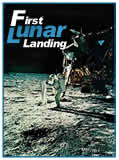|
 July 20, 1969. "Houston, Tranquility Base here. The Eagle has landed."
July 20, 1969. "Houston, Tranquility Base here. The Eagle has landed."
Television and radio waves carried Commander Neil Armstrong's historic message to people around the world. Apollo 11ís moon landing launched a new era in human exploration and renewed the rush to gather vital scientific information about the dangers of living and working in space.
Three years and several missions later, NASA was preparing to launch Apollo 17. On Aug. 2, 1972, five months before the scheduled mission launch, the sun erupted with a huge solar flare. The solar flare carried with it a burst of radioactive particles that sped outward in space. The event released huge amounts of atomic particles hundreds of times greater than a volcanic eruption.
The first wave from this solar event bathed Earth and the moon in X-rays. During a solar event an intense dose of X-rays and microwaves comes before the arrival of other radioactive particles. An astronaut standing on the sun side of the moon would have been engulfed in this deadly storm of electromagnetic radiation. Some experts believe the astronauts would have received a dose of more than 5,000 rems of radiation. This is five times the lethal dose for most people. This amount of radiation would have killed the astronauts inside their space ship as well.
Fortunately, for NASA and its mission, the solar storm lessened by December and the Apollo 17 launch. The astronauts conducted their mission safely.
Today, scientists are still constantly gathering data from the sun and trying to learn how to predict major solar events. Accurate solar predictions are needed to help the astronauts on board the space station prepare for dangerous bursts of solar radiation.
|


